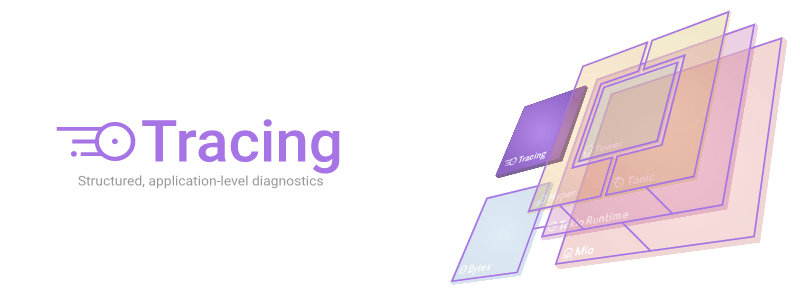2 unstable releases
| 0.2.0 | Dec 17, 2021 |
|---|---|
| 0.1.0 | Jul 12, 2020 |
#182 in Profiling
174,060 downloads per month
Used in 26 crates
(16 directly)
1MB
14K
SLoC
tracing-flame
A [tracing] Layer for generating a folded stack trace for generating flamegraphs
and flamecharts with inferno
Overview
tracing is a framework for instrumenting Rust programs to collect
scoped, structured, and async-aware diagnostics. tracing-flame provides helpers
for consuming tracing instrumentation that can later be visualized as a
flamegraph/flamechart. Flamegraphs/flamecharts are useful for identifying performance
bottlenecks in an application. For more details, see Brendan Gregg's post
on flamegraphs.
Compiler support: requires rustc 1.42+
Usage
This crate is meant to be used in a two step process:
- Capture textual representation of the spans that are entered and exited
with
FlameLayer. - Feed the textual representation into
inferno-flamegraphto generate the flamegraph or flamechart.
Note: when using a buffered writer as the writer for a FlameLayer, it is necessary to
ensure that the buffer has been flushed before the data is passed into
inferno-flamegraph. For more details on how to flush the internal writer
of the FlameLayer, see the docs for FlushGuard.
Layer Setup
use std::{fs::File, io::BufWriter};
use tracing_flame::FlameLayer;
use tracing_subscriber::{registry::Registry, prelude::*, fmt};
fn setup_global_subscriber() -> impl Drop {
let fmt_layer = fmt::Layer::default();
let (flame_layer, _guard) = FlameLayer::with_file("./tracing.folded").unwrap();
tracing_subscriber::registry()
.with(fmt_layer)
.with(flame_layer)
.init().
_guard
}
// your code here ..
As an alternative, you can provide any type that implements std::io::Write to
FlameLayer::new.
Generating the Image
To convert the textual representation of a flamegraph to a visual one, first install inferno:
cargo install inferno
Then, pass the file created by FlameLayer into inferno-flamegraph:
# flamegraph
cat tracing.folded | inferno-flamegraph > tracing-flamegraph.svg
# flamechart
cat tracing.folded | inferno-flamegraph --flamechart > tracing-flamechart.svg
Differences between flamegraphs and flamecharts
By default, inferno-flamegraph creates flamegraphs. Flamegraphs operate by
that collapsing identical stack frames and sorting them on the frame's names.
This behavior is great for multithreaded programs and long-running programs where the same frames occur many times, for short durations, because it reduces noise in the graph and gives the reader a better idea of the overall time spent in each part of the application.
However, it is sometimes desirable to preserve the exact ordering of events
as they were emitted by tracing-flame, so that it is clear when each
span is entered relative to others and get an accurate visual trace of
the execution of your program. This representation is best created with a
flamechart, which does not sort or collapse identical stack frames.
Supported Rust Versions
Tracing is built against the latest stable release. The minimum supported version is 1.42. The current Tracing version is not guaranteed to build on Rust versions earlier than the minimum supported version.
Tracing follows the same compiler support policies as the rest of the Tokio project. The current stable Rust compiler and the three most recent minor versions before it will always be supported. For example, if the current stable compiler version is 1.45, the minimum supported version will not be increased past 1.42, three minor versions prior. Increasing the minimum supported compiler version is not considered a semver breaking change as long as doing so complies with this policy.
License
This project is licensed under the MIT license.
Contribution
Unless you explicitly state otherwise, any contribution intentionally submitted for inclusion in Tracing by you, shall be licensed as MIT, without any additional terms or conditions.
Dependencies
~550KB
